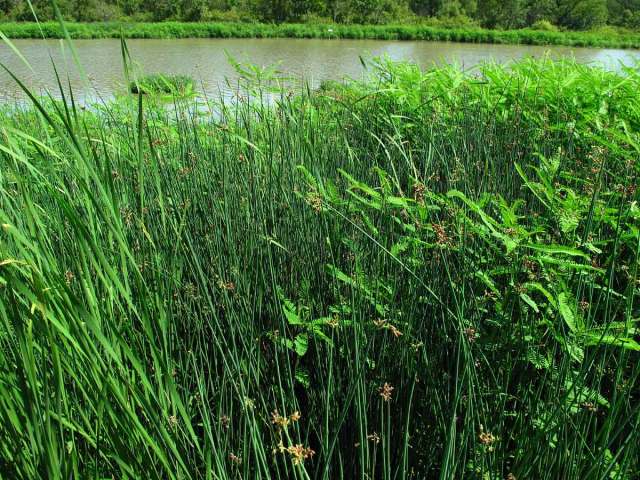.
Cryptic Camouflage by Color
Recently, I posted an article on Catocola Moths over at our other blog, Texas Travelers.
Click to see: Cryptic camouflage by pattern.
Martha and I were at the Nature Center Saturday and we made a point to find some Green Tree Frogs. They are easily overlooked unless you are specifically looking for them, and you are really paying attention.
Be sure to click on the photos to get a closer look !
Green Tree Frog in a Typical Marsh Habitat
Hyla cinerea
 Photographed from the boardwalk
Photographed from the boardwalk
It’s the small yellow-green dot in the center of the photo, on the left side of the reed, and near the top of the reed.
They usually prefer to rest about half-way up on the stems.
Hyla cinerea

A little closer look
Camera: Canon G10, Macro Mode
The habitat of American green tree frogs is usually near lakes, farm ponds, floodplain sloughs, cattail or reed marshes, and bald cypress swamps. They inhabit the southeastern United States and some areas to the north and west, including all of Florida, southern Georgia, Louisiana, Delaware, eastern Maryland and Virginia, eastern North and South Carolina, eastern Texas, and areas extending along the Mississippi Valley to southern Illinois. They may possibly inhabit northeastern Mexico. They are also known to inhabit Vancouver Island in British Columbia in Canada.
This is a common backyard species that can often be seen at porch lights, where they may gather to look for insects to eat. During the day, the green tree frogs may be found resting on the plants beside the pond.
The Green Tree Frog song/call can be found by clicking here.
Did you listen to the song?
Have you heard it before?
Here is the link to other frog songs/calls. Click here.
What frogs do you have and where? State, city, habitat.
Do you have a favorite?
I grew up in East Texas listening to ‘Spring Peepers’.
Please,
Leave a comment or write a paragraph.
Martha and I would like to know.
There is also an excellent ‘Article on Amphibians’ here.
Troy & Martha
.

Nice shot, Troy. The tree frog motto seems to be: Be heard and not seen.
Yep, that little guy would be really easy to miss… Enjoyed seeing the photos!
Pretty pretty pretty frog. Love that lime green coloring. Mother nature is grand.
Spring Peepers seem to be the most prevalent around here. There is a boggy place not far from my church where, when evening falls during the early summer, if one has car windows down, the sound of the frogs is almost overwhelming. I’ve not ever stopped to look, but there must be hundreds of them in this one small space… all singing at the same time. Love it!
Nice to sit at my computer and enjoy the tree frog subject matter. I like the pic. Thanks.
JSM
Troy, I didn’t listen to the recording because it is the middle of the night and Gus and my grandson are sleeping but, I like the information and the photo of the frog. I grew up with all kinds of toads and frogs in CT but I could not tell you their species name. There were always these little tiny frogs or toads in the summer at the campground we use to go to by a lake. They were smaller than a dime and we would see them hopping in the grass and sand near the beach as we walked. Here in AZ we have a sand colored tree frog that I have seen a few times in Sabino Canyon, most notably when I have gone to use the restroom. One jumped out of the toilet paper dispenser one time and I have found them in the sink a couple of times when I went to wash my hands!
Very cool shot, and interesting info, still had to look long and hard for the frog,lol.
We have anywhere from five to fifty little guys on our windows each night in southeast Georgia. They can be pretty loud when they want to! They also have been known to hop into our house from our backyard on hot, sticky afternoons. The kids love it, but they leave a messy residue which I’m sure is helpful for holding on to the glass!